The Mariposa Biomass Project Introduction and FAQ
The Mariposa Biomass Project has been exploring the idea of a woody biomass facility in Mariposa County that would use slash from forest thinning projects for the generation of bioenergy and commercial byproducts. The facility would produce a revenue stream that should help finance forest thinning projects, attract new industries and jobs to the County, and possibly have other positive economic and environmental benefits for the county and the region. 
Much of the impetus for this project is the growing recognition that we need to reduce the fuel load in our forests for the sake of forest health and fire safety. The big question was what is the best way to deal with the slash produced in this effort with respect to costs and benefits to the environment, climate change and our local economy?

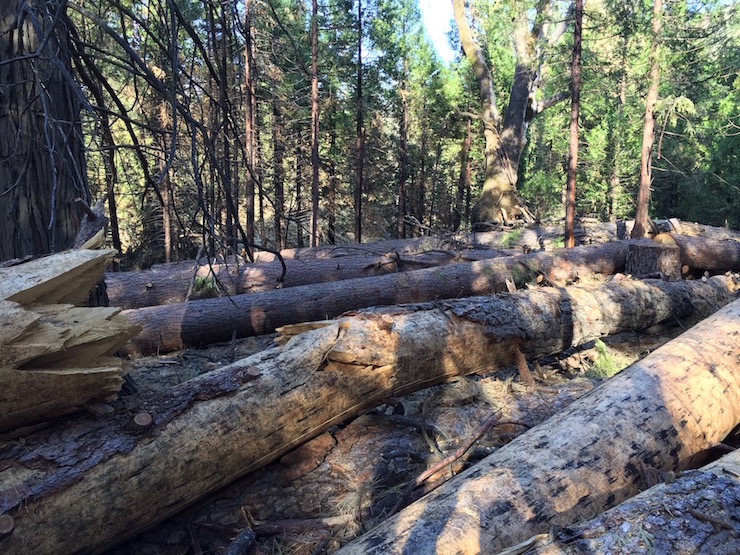
And now we have tree mortality to deal with and the glut of dead and down wood, some of which needs to be removed from around homes and public infrastructure. What is the highest and best use for that wood?
As we consider such a project there are many factors to consider: What is the sustainable level of the biomass supply? What is the right type and size of woody biomass facility to construct? Where should it be located? How can it be financed? Are there environmental or other groups likely to oppose this project and, if so, for what reasons?
As a web-based introduction to the Mariposa Biomass Project, we have put most of the materials in the earlier white paper into a Q and A format. As the number of questions in the FAQ was getting long, we have now arranged questions into categories. The categories below have a larger font size. Click on a category to expand that category and see the questions within that category. Click on a question to see the answer; click on the question again to hide to answer, and click on the category again to hide the questions in that category.
What is biomass and what is your source of fuel?
What is biomass?
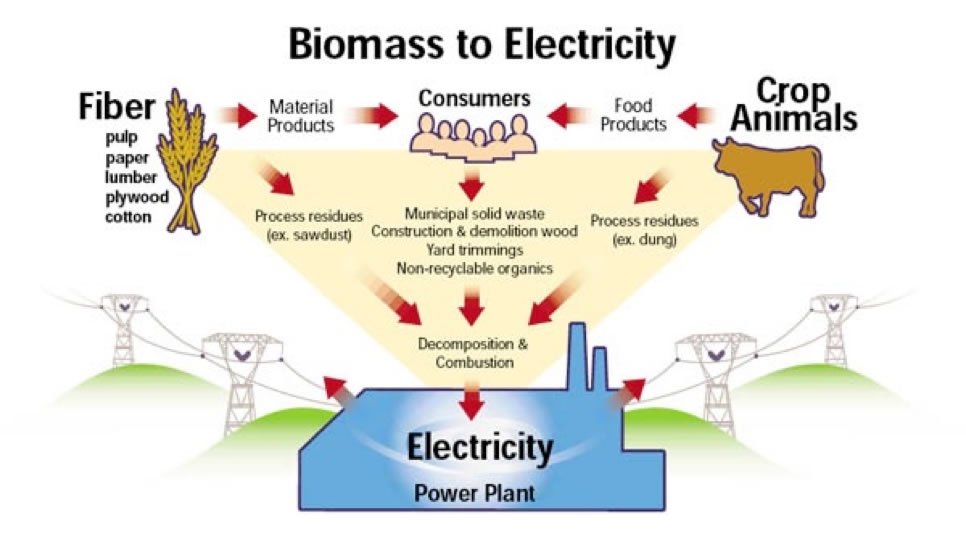
Biomass can indicate a wide range of sources of organic materials that can be converted to energy (bioenergy), ranging from agricultural byproducts, consumer waste and woody or cellulosic biomass from either forest thinning activities or harvesting or sustainable biomass crops.
From where will the biomass for this project be obtained?
The Mariposa Biomass project expects to obtain mainly woody or cellulosic biomass from clearing trees and brush around public infrastructure, public utility right-of-ways and thinning of the forested areas along the 140 and 49 corridors in Mariposa County. The expected sources include Yosemite National Park, Sierra and Stanislaus National Forests, land managed by the Bureau of Land Management, private land owners, and commercial tree/brush cutting operations. The economic model for similar biomass operations in California includes payment for forest-based biomass, thus helping to defray transportation costs. The general rule of thumb is that biomass for use in bioenergy can be hauled for 30 to 50 miles and still be economically viable, however, the closer the biomass facility is to the source of the biomass, the less expense incurred.
What forest materials do you plan to remove? Will timber or sawlogs come out of the forest under this project? Are you promoting clear cutting?
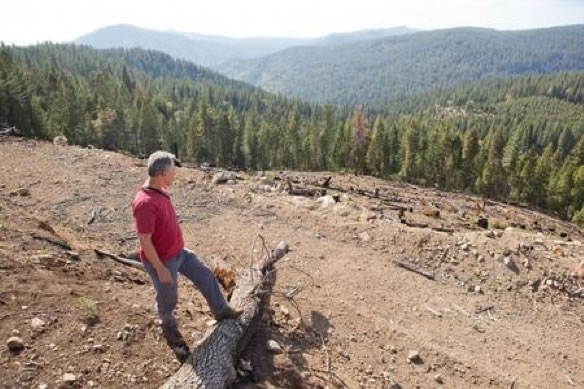 The emphasis of our project at the beginning was focused on how to obtain value for the small diameter forest products, slash and trees less than 6 inches in diameter, that inevitably arise from any forest thinning or timber harvesting activities, especially those aimed at reducing fire risk. We hoped that by creating a value for the slash and small diameter trees, forest thinning activities aimed at creating a healthy forest, rather than clear cutting (pictured above), would be more economically viable and would preserve habitat and enhance recreation in the area. In such thinning activities, some larger diameter timber may well be available for sawlogs. Now with tree mortality rampant in our area, we have a new opportunity to use the dead trees that need to be removed for public safety as a source of fuel.
The emphasis of our project at the beginning was focused on how to obtain value for the small diameter forest products, slash and trees less than 6 inches in diameter, that inevitably arise from any forest thinning or timber harvesting activities, especially those aimed at reducing fire risk. We hoped that by creating a value for the slash and small diameter trees, forest thinning activities aimed at creating a healthy forest, rather than clear cutting (pictured above), would be more economically viable and would preserve habitat and enhance recreation in the area. In such thinning activities, some larger diameter timber may well be available for sawlogs. Now with tree mortality rampant in our area, we have a new opportunity to use the dead trees that need to be removed for public safety as a source of fuel.
I hear people say that our forests are not "healthy" because of the fuel build-up. What exactly is a healthy forest?
There are many opinions on this question. For the sake of this discussion, we define a healthy forest as a forest with two primary attributes: Resiliency and Diversity. Resiliency means that a wildfire can pass through the forest without utterly destroying it. That means few if any trees are killed, some brushy areas will survive, and some habitat will remain. Diversity is of three kinds: Plant diversity, wildlife diversity, and forest structure diversity. There are different forest structures: park-like, open, dense, understory (brushy, limbs on the ground), etc. We need to aim toward diversity – a mosaic – of forest structures. The size of each piece could range from an acre, to several acres, to several hundred acres. Diversity of forest structure helps resiliency, and it fosters plant and wildlife diversity as well. Achieving structural diversity is of absolute importance to having plant and wildlife diversity.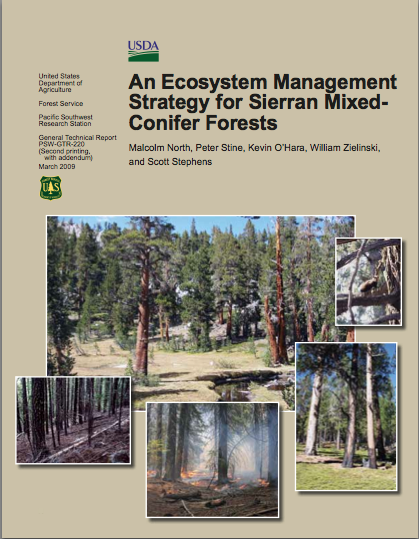
There is no doubt that many of our forests have become significantly overgrown through misguided fire suppression efforts and neglect. According to Prof. Roger Bales of the University of California at Merced, if one compares today's forests to photos of historical forests where frequent wildfires controlled growth, today's forests have about twice the biomass and about four times the number of stems. This would suggest that historical healthy forests had a greater percentage of large trees compared to current forests that have an excess of younger trees and underbrush. Restoring forest health will therefore involve removing much of the small diameter trees and underbrush while retaining many of the more mature trees, thus increasing the importance of obtaining value for small diameter trees and slash.
In many cases, government entities that are doing the forest thinning will have their own standards, such as the Forest Service's GTR-220.
What does fuel reduction have to do with having a healthy forest?
Fuel reduction, when planned and practiced properly, can achieve the kind of mosaic described above that promotes resiliency and diversity. That means creating some park-like areas and some open areas in place of dense areas and understory areas, but being careful to leave some of those areas untreated.
Doesn't reducing fuel in our forests destroy wildlife habitat? I am not in favor of reducing fuel if it does.
The simple answer is "yes it does". But the issue is much more complex than that. Our forests have been deprived of fire for decades, allowing a very heavy build-up of flammable materials (brush, limbs too close to the ground, dead wood, pine needles, and the like) to occur. This build-up means that when a fire does occur, a forest can be completely destroyed, and there will be no habitat left whatsoever. Removing some (not all) of that fuel, while it decreases habitat, will prevent the total destruction of the forest (and all habitat) in case of a wildfire. Wildfire is a certainty… it is only a question of when.
How will restoring forest health affect the water from our watersheds?
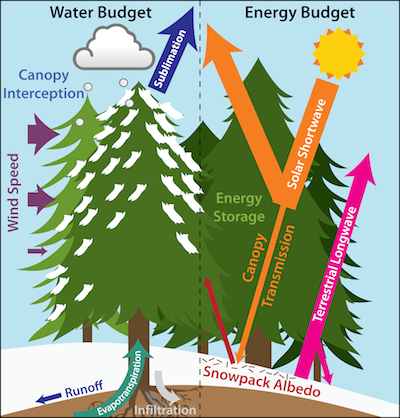 The relationship between trees and water production in our watersheds is complex. On the one hand, trees pull water from the ground and return it to the atmosphere and so fewer trees mean less water is lost via evapotranspiration. Trees also capture snow in the canopy and that snow may evaporate (sublime) before it ever hits the ground. On the other hand, trees protect the snowpack from melting, especially at low sun angles, thus preserving the snowpack and delaying snowpack melt. The most significant effect of forest density on water production and timing is at higher elevations where, historically at least, the snowpack forms. According to Prof. Roger Bales of the University of California at Merced, with a 50% reduction in biomass at 7000 ft elevation, we would expect to see a 10-30% increase in stream flow, as was recently pointed out in a Sacramento Bee Viewpoints by Mariposa resident, Tom DeVries.
The relationship between trees and water production in our watersheds is complex. On the one hand, trees pull water from the ground and return it to the atmosphere and so fewer trees mean less water is lost via evapotranspiration. Trees also capture snow in the canopy and that snow may evaporate (sublime) before it ever hits the ground. On the other hand, trees protect the snowpack from melting, especially at low sun angles, thus preserving the snowpack and delaying snowpack melt. The most significant effect of forest density on water production and timing is at higher elevations where, historically at least, the snowpack forms. According to Prof. Roger Bales of the University of California at Merced, with a 50% reduction in biomass at 7000 ft elevation, we would expect to see a 10-30% increase in stream flow, as was recently pointed out in a Sacramento Bee Viewpoints by Mariposa resident, Tom DeVries.
Is it a good idea to remove that much material and valuable nutrients from the forest?
That is a very good question and we have asked the Forest Service for opinion about this issue. Their response was, Take all the nutrition our of the forest you wish. Take even more. The forest floor has plenty of nutrition". So it seems that in the short-term this is not a problem, but it is worth remembering as an issue for the future.
Will this project mean that I can't have a burn pile? What about prescribed burns in the forest?
 No. There is no intention to ban burn piles or prescribed burns. We realize that many areas of the county will not have convenient access to roads or the slopes maybe too steep to make trucking slash to the facility practical. We hope to change to economics so that anyone wanting to drop off slash at the facility could receive a modest payment rather than paying a tipping fee as is currently the case at the Solid Waste Facility.
No. There is no intention to ban burn piles or prescribed burns. We realize that many areas of the county will not have convenient access to roads or the slopes maybe too steep to make trucking slash to the facility practical. We hope to change to economics so that anyone wanting to drop off slash at the facility could receive a modest payment rather than paying a tipping fee as is currently the case at the Solid Waste Facility.
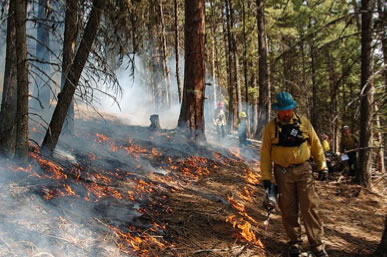 As to prescribed burns in the forest, that will most likely be the lowest cost and most natural way to maintain the forest, especially once the excess fuel has been removed. The problem with prescribed burns is that there are few windows each year when the conditions are right to do these burns safely. While burn piles and prescribed burns will likely always be part of rural life, the smoke from those burns causes health problems and the air quality impacts have to be taken into account by the local air quality boards.
As to prescribed burns in the forest, that will most likely be the lowest cost and most natural way to maintain the forest, especially once the excess fuel has been removed. The problem with prescribed burns is that there are few windows each year when the conditions are right to do these burns safely. While burn piles and prescribed burns will likely always be part of rural life, the smoke from those burns causes health problems and the air quality impacts have to be taken into account by the local air quality boards.
If there is a biomass facility in Mariposa County, we hope that large forest clearing projects as well as individuals maintaining their defensible space would take advantage of the opportunity to diversify Mariposa's economy while making clean green energy and valuable byproducts.
How does Tree Mortality affect your project?
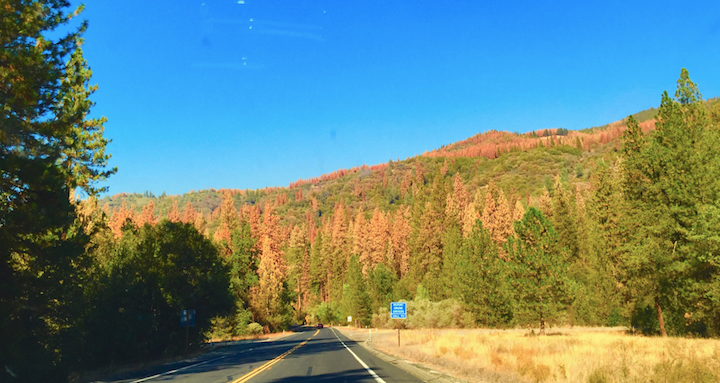
As mentioned above, our original focus was on using woody biomass from sustainable forest thinning operations as part of efforts to restore forest health, and we have sized our biomass plant accordingly. Unfortunately since we got started, the Central and Southern Sierra, where we are located, has experienced significant tree mortality with mortality rates for pine trees greater than 90% of in some of our communities. Not all of the dead trees can or should be removed as they do provide habitat, but some dead trees need to be removed for reasons of public safety. The need to clear these dead trees from around homes and public infrastructure has led to a glut of potential fuel for biomass plants.
In response to this tree mortality disaster, the Governor of California has declared a State of Emergency relative to Tree Mortality in the Sierra as well as issuing a proclamation that orders state agencies to help in a wide variety of ways. Five of the nineteen items in the Governor’s proclamation were aimed directly at encouraging small-scale community-based biomass plant that would use these dead trees for fuel.
The Governor has also ordered the formation of a task force headed by the Directors of CalFIRE and the Office of Emergency Services to guide how the proclamation is implemented. One of our group’s founders, Rosemarie Smallcombe, who is currently a Mariposa County Supervisor, serves on the Governor’s Tree Mortality Task Force as well as the Bioenergy and Regulations working groups. She is able to keep our group informed of what is happening at the State level.
Over the next five to ten years, the tree mortality disaster will provide us with fuel at a cost likely to be well below that which we used in our financial analysis of the profitability of the project.
Will your biomass plant increase air pollution in our community?
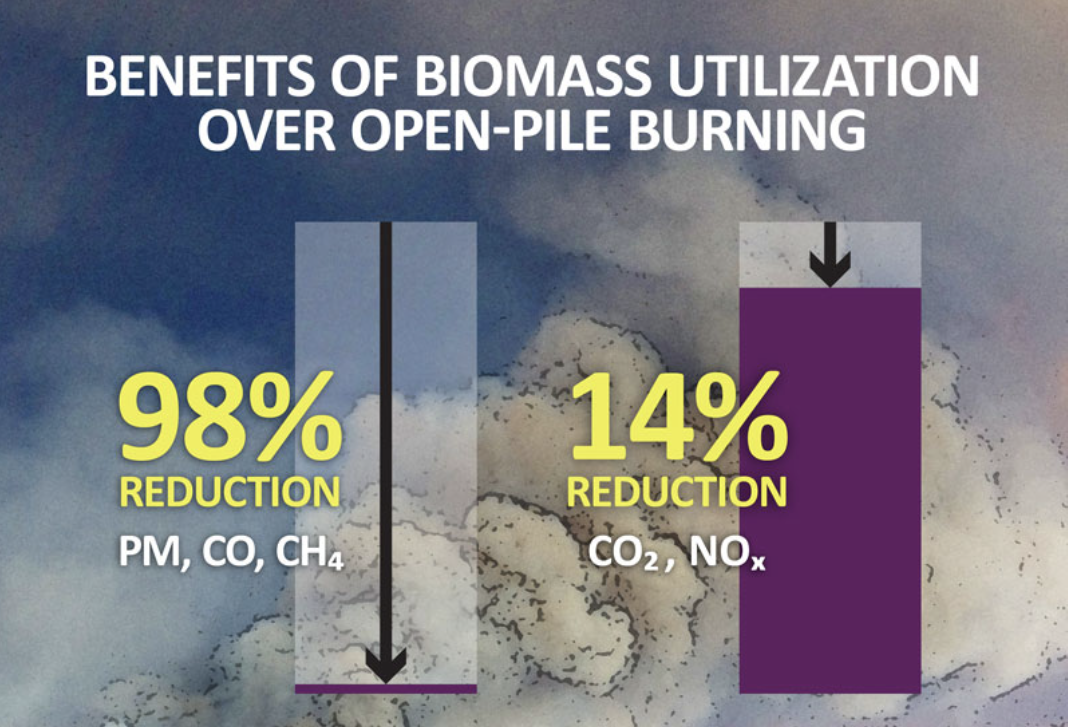
One concern often expressed about biomass plants involves air pollution, with the assumption that a biomass plant would increase air pollution. The truth is just the opposite. The biomass we will use at our plant is biomass that needs to be disposed of for reasons of public safety, e.g. forest waste from around our roads and public infrastructure, under power lines, from fuel breaks, or removed from defensible space around our homes. Much of this forest waste would otherwise be open pile burned causing significant air pollution. Or, worse, yet, burned in a wildfire, producing not only dense smoke while endangering our homes and lives.
Because modern biomass plants use BACT, Best Available Control Technology, to reduce the NOx and particulate matter from their exhaust stack, disposing of waste forest biomass in a biomass plant actually reduces air pollution.
Let’s look at it this way, our project is based on a the BioMAT program established by Senate Bill 1122, which passed the Senate 38:0, and was signed by the Governor after passing the Assembly. Our project is supported by two grants from agencies of the State of California, Cal Fire and the California Energy Commission. And, as we all know, California has very strict air quality standards. The project’s most recent grant is from the Office of Clean Energy Development at the US Department of Energy. Would these agencies support projects that produced significant air pollution? Of course not.
Our Fire Safe Council and Resource Conservation District are continuously applying for grants for fire breaks and fuel reduction projects and more and more of those grants now require that the material removed by these projects be taken to biomass plants for disposal in a way that minimizes air pollution. Our project will help these agencies get more grants which will make us all safer.
California’s draft Carbon Forest Plan included the above figure to illustrate a 98% reduction in air pollution from using a biomass plant for disposal of forest waste relative to open pile burning. And given recent improvement in BACT since that study, it is likely that our plant will reduce air pollution even more!
The other issue related to air pollution is the exhaust from the diesel trucks that haul logs or chips from the source of the fuel to the biomass plants. For the reasons outlined above, biomass that must be removed for reasons of public safety is best disposed of at a biomass plant rather than burning it in place. This necessarily involves transportation, and the shorter distance that biomass is transported the better from the point of view of air pollution as well as greenhouse gas emissions and climate change. Currently, and especially in the years following the tree mortality disaster in 2015, diesel trucks have been hauling logs and/or chips from our community to the nearest biomass plants which are in Fresno or Chinese Camp, both one-way trips of about 100 miles. Having a local biomass plant within 10-30 miles of the sources of the biomass will obviously also reduce the air pollution associated with the transportation of that biomass.
When we were applying for our Conditional Use Permit, we asked the head of the head of the Health Services Division of our County Government that manages our Air Pollution District for a letter of support. He checked with the California Air Pollution Control Officers Association and found that indeed, statewide Air Pollution Districts and their managers support biomass plants as a way of significantly reducing air pollution!
Will your biomass plant mean that we have to SMOG check our cars?
It has been suggested by a critic of the project that our biomass plant would mean that our county would be labeled a pollution contributor or have “stationary source” or permanent source of air pollution, and as a result county residents would have to “smog check” their cars and additional controls might be imposed on wood-burning stoves and fireplaces.
This is of course not true. The simple answer is that the Mariposa Air Pollution Control District has approved the project, and in doing so has confirmed that the facility will not impact the air attainment status of the Mariposa Air Pollution Control District. This means that the limited emissions of the project will not impact the applicable National Ambient Air Quality Standards or the associated State Implementation Plan (SIP), so this project will have no impact on smog check requirements in Mariposa County.
Will the project involve a steam turbine?
At a recent Board of Supervisors meeting, we heard that you will be using a steam turbine that involves very high temperatures and pressures, endangering our community. Is that true?
While it is true that large, e.g. 100 MW biomass plants do use steam turbines, we have never even considered one for our project as steam turbines to not scale well (inefficient) to the less than 3MW size associated with the small local biomass plants, such as ours, that are being encouraged by the State of California. Plus, steam turbines use a lot of water both for the steam generation as well as in the cooling towers. No steam turbines for our project!
Instead, our project involves an Organic Rankin Cycle (“ORC”) closed loop system as illustrated on the home page. ORCs are considered to be the best way of utilizing low-grade heat sources and operate at much lower temperatures and pressures than steam turbines. Also, ORCs do not require the water-cooling towers associated with steam turbines and thus our plant will use no water other than for dust control and domestic use.
How does your project compare to other biomass plants?
Is biomass a new idea? How are the ideas behind this proposal different?
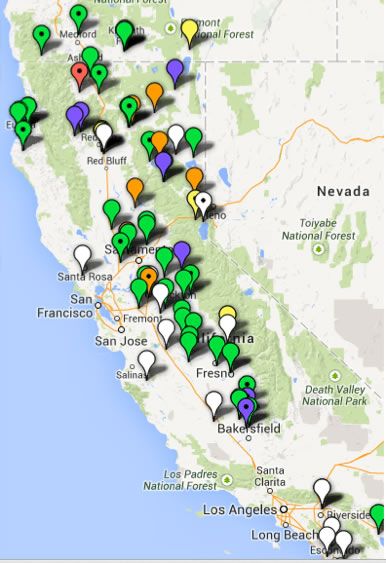 No, in fact, there are over 100 biomass plants in California today, some idle, but most are in operation and many use either agricultural products or forest slash. Most of these existing biomass plants were built in the 80s and 90s. We refer to these plants as "your fathers biomass plants" as a way of suggesting that we are proposing something new – a small-scale biomass plant, located near the source of excess forest biomass and based on an Organic Rankine Cycle turbine, rather a larger-scale steam turbine, to drive a generator that will generate clean, green, renewable energy, while supplying good paying jobs for our local community.
No, in fact, there are over 100 biomass plants in California today, some idle, but most are in operation and many use either agricultural products or forest slash. Most of these existing biomass plants were built in the 80s and 90s. We refer to these plants as "your fathers biomass plants" as a way of suggesting that we are proposing something new – a small-scale biomass plant, located near the source of excess forest biomass and based on an Organic Rankine Cycle turbine, rather a larger-scale steam turbine, to drive a generator that will generate clean, green, renewable energy, while supplying good paying jobs for our local community.
We have heard horror stories about a biomass plant in Merced? Didn't they just get a huge fine for air pollution? Do we want such a facility in Mariposa?
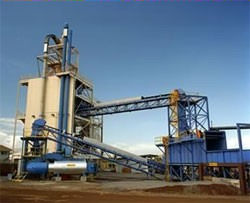 There have been two 12.5 megawatt biomass facilities in operation in Chowchilla and El Nido for many years. The El Nido plant is at the junction of 59 with Sandy Mush road. These plants are a good example of a traditional combustion-based biomass facility built in the 80s. And yes, in 2011 they received a very large fine for violating clean air standards. The El Nido plant, however is back in operation today with improved air pollution controls. The biomass plant we are considering will meet all current air quality standards.
There have been two 12.5 megawatt biomass facilities in operation in Chowchilla and El Nido for many years. The El Nido plant is at the junction of 59 with Sandy Mush road. These plants are a good example of a traditional combustion-based biomass facility built in the 80s. And yes, in 2011 they received a very large fine for violating clean air standards. The El Nido plant, however is back in operation today with improved air pollution controls. The biomass plant we are considering will meet all current air quality standards.
On the news lately I have heard about biomass plants going out of business as they can't make money. What gives? Why are you considering starting a new one?
As you may have read above, many biomass plants were built about 30 years ago and at the time received favorable contracts with power providers such as PG&E. Those contracts are now expiring and the older biomass plants find that they cannot compete in the current energy market as the price of natural gas has gone down fairly significantly. An older biomass plant manager was recently quoted a saying that we have to pay for our fuel while wind an solar is free, so we need subsidies to help pay for our fuel. AB 590 seeks to address this problem and that is a good thing. While some of the answers above have criticized these older plants as not being as "green" as one might possibly like, many these plants do provide a way for disposal of agricultural waste and byproducts in a way that is much more environmentally sound than simply burning those same waste product in open piles in the fields. And since these plants pay farmers for that waste, eliminating those plants and payments would just make the situation that much worse for farmers currently also struggling with the drought.
The situation we are facing is a bit brighter as SB 1122 will allow biomass plants using biomass sustainably harvested from our forests to obtain very favorable contracts under the BioMAT program. SB 1122 contracts will be sold in a auction, which has now started, and we should be able to obtain a 10 to 20 year contract at a favorable rate.
It should also be noted that under the BioRAM program, at the time of this writing, six of these older larger biomass plants have now obtained favorable contracts that allow them to resume or continue operation if they are willing to take forest biomass from high hazard zones associated with tree mortality as the source for at least 50% of their fuel.
Are biomass-to-electricity projects green?
Can biomass energy be considered clean, green carbon neutral energy?
The answer is, it depends.
There has been a fair number of news articles lately, such as this one on Climate Central, about the wood pellet industry and the fact that we are harvesting trees in the U.S. to make wood pellets for use as fuel in power plants in Europe and Asia. In fact the majority of “renewable energy” in Europe comes from burning wood, and according to Climate Central article, the power plants burning the wood are getting tax credits aimed at mitigating climate change, and yet the article alleges that those plants making climate change worse! The article claims that wood-based energy exploits a loophole that allows wood to be considered renewable to the detriment of our planet?
So why are we considering a biomass plant in Mariposa? Should we be shutting down all the biomass plants in the Central Valley that burn agricultural waste, e.g. orchard trimming, almond shells and peach pits because burning biomass is contributing to global warming? The answers to these questions are not simple and include analysis of the fuel sources and the alternatives for disposal of various biomass waste streams, and the fact that one does not need to burn the biomass and release all the carbon to make electricity. One can use other technologies that actually help reverse climate change rather than exacerbating it. The devil is in the details. So what is the truth and how does the Mariposa Biomass Project fit into all this? Click here to find out.
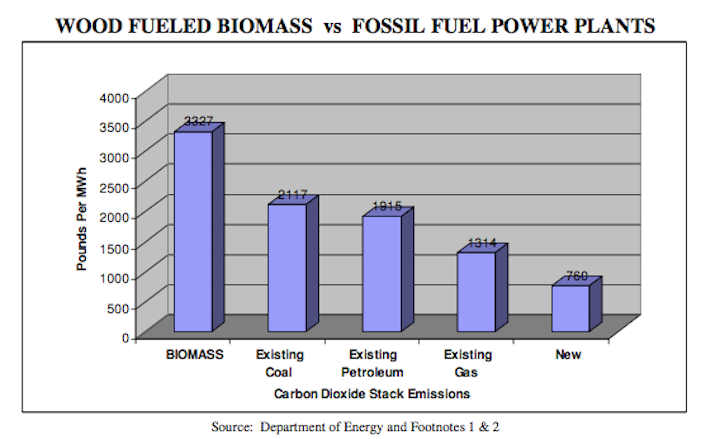
It is also often mentioned that biomass facilities produce more CO2 per kilowatt hour of electricity than power plants with other fuel sources. While this is true in general, if the fuel involved was dead and down wood or trees and brush that needed to be removed for reasons of public safety, the carbon in that wood would be released within a matter of a few years anyway, if left to rot in the forest or burned in a burn pile or air curtain burner. We feel that deriving electricity from dead and down wood, as we will be doing, especially given tree mortality, can be considered carbon neutral as it is not releasing carbon that would not be otherwise be release in the near future. Furthermore we will generate electricity that is considered by the State to be renewable baseload energy - not intermittent like wind and solar, but available 24/7/365 - displacing the need to use fossil fuels for that same energy. The details matter.
How do environmental groups feel about biomass facilities?
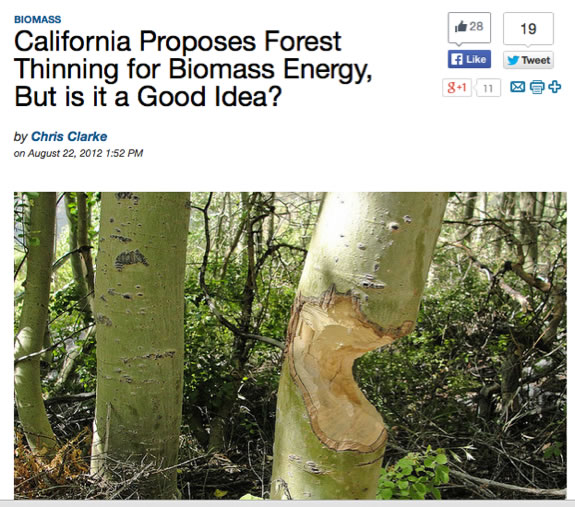 Environmental groups have been opposed to biomass for a number of reasons. First as pointed out above, some biomass projects involve cutting down live trees specifically for use as fuel and that biomass in pressed into pellets and shipped long distances for use in “green” energy facilities. We would agree that this use of biomass is neither clean or green as that ability to sequester carbon may take 50 to 100 years to recover. Read more about his here.
Environmental groups have been opposed to biomass for a number of reasons. First as pointed out above, some biomass projects involve cutting down live trees specifically for use as fuel and that biomass in pressed into pellets and shipped long distances for use in “green” energy facilities. We would agree that this use of biomass is neither clean or green as that ability to sequester carbon may take 50 to 100 years to recover. Read more about his here.
Environmental groups such as the Center for Biological Diversity and the National Resource Defense Council have also considered biomass as an euphemism or "Trojan Horse" for clear cutting. The fear is that once such a facility is established, it will provide economic incentive to remove more fuel from the forest than is needed for forest health and fire safety. When a tree or brush is removed from the forest and burned, one not only releases the carbon already sequester by that tree, but one also eliminates the ability of that tree to sequester carbon in the future. So a good rule of thumb is that no tree should be cut or removed from the forest solely for the purpose of creating bioenergy.
If however, that tree or brush needs to be removed for other purposes, e.g. fire safely, then it is far better, to the extent practical, to use that biomass to create electricity and rather than to burn it in place. It is therefore critical to size any biomass facility on the sustainable level of fuel from the forest, rather than on the peak level of fuel that we have currently available due to tree mortality. In all of our talks about the project we try and say that we never want to hear the captain say, “Scotty, we need more power; go cut down some trees”. We want to size our plant so that will not have to happen.
Have you selected a vendor? How will it relate to the non-profit Biomass Project?
Have you chosen a vendor?
We are now working with West Biofuels, a company located in Northern California.
What size of a biomass facility are you planning?
We are planning on building a 2.4 MW biomass plant.
What ownership structure is being considered?
Current plans are for the biomass plant will be owned and operated by Mariposa Bioenergy LLC and in return for our efforts to establish this project, the non-profit Mariposa Biomass Project will receive yearly payments that will be used to help pay for projects around the community that will help mitigate the the potential damaging effects of wildfire on our homes and public infrastructure.
Where will the project be located?
What are the requirements for siting a biomass facility?
The primary requirement is proximity to a electrical utility company’s substation, a PG&E substation in our case, so that we can feed the electricity we generate into the grid and generate revenue via a Feed In Tariff negotiated with PG&E. Industrial zoning is also a requirement. A 3 megawatt biomass plant, the associated generator(s), peripheral structures and facilities, water tanks, office, employee parking, etc. and will fit in about 2.5 acres of land.
Since the supply of biomass is likely to be seasonal and biomass-based electricity produced year around, the biomass reactor needs to be located at or near a place to store the biomass in the form of chips. Depending on the nature of our fuel supply agreements, we will also need an area for local biomass storage of between 1 and 3 acres.
Have you selected a site for the Mariposa Biomass Project?

The Mariposa Biomass group, using funds from local investors, has purchased a parcel in the Mariposa Industrial Park (67), and has leased, with option to buy, a second parcel, so we now have the site control required by various grants and necessary to obtain County Permits. The biomass plant will be located on the parcel 067 (bottom left) and our fuel storage area will be on parcel 066 (top left).
One of the advantages of locating in the Mariposa Industrial Park is that it is zoned for industrial use, as opposed to light industrial, and has well defined standards for the heights of building and allowable noise levels. We have done a noise study as a part of our County Use Permit. We are confident that we can meet the required noise levels at our property boundaries and at Highway 49.
Does the project make sense financially? How is it being financed?
Some critics have said the costs to harvest, chip and transport forest biomass to a biomass plant is cost prohibitive and that such projects do not make financial sense. How do you answer that criticism?
The problem is that is you cannot associate a single cost with forest biomass. The actual costs depend on the details - how close is the fuel to a road, how steep is the slope where it is located, how far is the haul to the plant, does this wood need to be removed for reasons of public safety, etc.. Our project started with a fuel availability study, generously paid for by the Mariposa FireSafe Council, that assured us that we would have a sustainable source of affordable fuel for the foreseeable future. We have sized our plant based on that study.
Yes, removing biomass from the side of Miami Mountain would be cost prohibitive, but there is a lot of biomass located near roads, homes, businesses and public utility right of ways (around power lines) that need to be harvested and disposed of. Without a local biomass plant this woody biomass is being shipped to Fresno or Sonora for disposal at biomass plants there. Right now, given the glut of dead wood associated with tree mortality, biomass is practically being given away to anyone who will take it. Other biomass is currently being burned on site or taken to our County landfill where it will be stored and burned in an air curtain burner when it can be safely done (not during fire season). Neither of these things make sense financially, but they are being done as the fuel cannot be left where it was harvested for reasons of public safety.
Right now the County is burning logs at the landfill, which gets rid of the wood, but is certainly not the highest and best use for that fuel. By converting that same fuel to clean green renewable baseload (available 24/7/365) electricity at the proposed biomass plant, located at the industrial park near the landfill, we will be able to generate ~$5 million dollars in revenue based on an average of 4-5 chip trucks of fuel a day. That makes financial sense for us, and likely for the County as well, if they choose to sell us that fuel rather than store it or burn it.
Can we sell electricity to PG&E at a good price?
Fortunately, legislation passed in 2012, S.B 1122, allows for very favorable Feed In Tariff rates for small community-based biomass plants like the one we are planning. It has taken a while to get the auction process going that was authorized by S.B. 1122 due to a financial requirement that small biomass plant could not easily meet. At the request of the Governor’s Tree Mortality Task Force, recent legislation, rulings by the Public Utilities Commission and Administrative Law Judge associate with the PUC, have cleared these prior hurdles and the auction has now started.
What is the source of funding?
We have received a planning grant for $244,080 from the U.S. Forest Service that we used to pay for County permits and our CEQA review as well as our PG&E system impact study. We also received an EPIC grant from the California Energy Commission for $5 million for the construction of a demonstration biomass plant in Mariposa County. The rest of the funding will be provided by Mariposa Bioenergy LLC and their investors. There is no County money involved or at risk.
How does your project affect the community? Jobs? Water usage? Traffic?
How many jobs will the facility support?
We expect to employ 8-10 full time employees at the facility with an average salary of $60,000/year. We would also estimate that our facility will also support 20-30 year around jobs harvesting the biomass and transporting it to our facility.
How much biomass is required to operate a 2.4 megawatt biomass facility? Will there be a significant increase in truck traffic?
A 2.4 megawatt facility will need ~4-5 chip truck loads a day to sustain operation. That is about the same number of cars and trucks that go down Highway 49N every minute during the day.
Perhaps the most important point is that this will not increase traffic as the log trucks and chip trucks are already rolling down our roads, taking logs and biomass to Sacramento, Sonora and Fresno. While most of the trees that have died in the recent tree mortality disaster will be left in place, many need to be removed for reasons of public safety. That biomass needs to go somewhere and currently chipped biomass from Mariposa County is being trucked to Sonora (Chinese Station) and Fresno. Wood debris and logs are also being taken to and stored at the Mariposa landfill to be burned with an air curtain burner.
If those same trucks that are going to Fresno or Sonora could deliver biomass to a local facility, adjacent to the landfill, that would mean much shorter trips, saving time, fuel and air pollution. If the biomass being stored at the landfill could be cleanly converted to electricity and therefore dollars, that would be a win for everybody, as those dollars create jobs and help pay for the removal of excess vegetation and fuel from around public infrastructure.
Does this mean that our plant can take all of the biomass that is currently being shipped to Sonora and Fresno? Not even close, as we are planning much smaller plant than those facilities. The point is that the traffic coming to our biomass plant will not be incremental trips. Those trucks are already on our roads. Shorter trips, yes. More trips, no.
Highway 49 has been recently closed 3 times in a week when log trucks rolled over or had an accident. Do we really want more log trucks in our community?
It is pretty obvious that, as stated above, log trucks are rolling down our roads right now, as logs and chips need to be removed from where they were felled for reasons of public safety. Currently these trucks are taking much longer and more difficult trips to Sonora or Fresno than would be involved in getting to the Industrial Park near the County Sold Waste Facility. Having a local biomass plant would actually reduce the number of miles those trucks need to travel on our roads and therefore likely reduce the number of accidents.
We have heard the biomass plants use a lot of water. Is your plant appropriate for Mariposa County where we have limited water available?
The quick answer is that many power plants, including some biomass plants, do use a lot of water, but our plant will not as we are using a very different technology for generating the electricity - an Organic Rankine Cycle turbine rather than a steam turbine. In fact, the West Biofuels process does not use any water in the conversion of biomass to electricity. Of course, like any business some water will be needed for domestic water use, dust control and stored for fire suppression.
How much of Mariposa electrical needs will this facility generate?
A 2.4 MW facility will produce approximately 20% of the County's electrical usage, based on 2015 data from the California Energy Commission.
Will Steve Smallcombe make money off of the biomas project and
does Supervisor Rosemarie Smallcombe have a conflict of interest over this project?
Opponents of the biomass project have fairly frequently stated that Supervisor Rosemarie Smallcombe and her husband, Steve, have financial interest in the project and Rosemarie involvement in Board decisions on the project have been a conflict of interest.
Rosemarie and Steve Smallcombe were involved in the establishment of the non-profit Mariposa Biomass group in 2013-2014. However, when Rosemarie was elected to the Mariposa County Board of Supervisors in 2014, she stepped back from her role in the Marposa biomass project, while Steve continued to serve as the Chief Technical Officer on a voluntary basis. Steve is also the webmaster for this site and does so without any compensation for his time and efforts.
Neither Steve nor Rosemarie have ever invested in the project and do not now have, or ever have had, a financial interest in the project.
In terms of Rosemarie’s actions as a County Supervisor, she has always recused herself from any discussion or decisions concerning the project. In doing so, she has stated that “Although neither I or my husband have a financial interest in the project, a reasonable person might conclude that because of my husband’s involvement, I might be biased. I therefor recuse myself from this discussion” and leaves the room.
Rosemarie has always behaved impeccably, in this regard and has gone further in removing herself from discussions or decision-making than the law would require.
You have talked a lot about biochar in the past. How does it fit into your current plans?
Those who have been studying this site in the past know that we have been quite excited about the possibility of producing biochar as well as electricity with our biomass facility. Right now however, thanks to S.B. 1122 and the BioMAT program, one can negotiate long-term contracts with power companies such as PG&E at favorable prices. These are contracts you can “take to the bank” when attracting investors. Biochar on the other hand is currently more of a boutique market without the possibility of long-term contracts.
We are still very interested in developing the biochar market and are working with U.C. Merced on research to allow biochar to be converted to activated carbon for use in water treatment plants. This market does not currently exist and we need to get our project off an running before it will likely be at the stage where it would make economic sense to divert divert potential energy from the wood to make biochar. One of the things, however, we really like about the West Biofuels process is the ability to either convert the biomass to electricity or divert it for use as biochar/activated carbon. Of course, if we did divert char for use as biochar that would lower our electrical output unless we used more fuel. Obviously this is something we need to think about in terms of any contractual agreements for sale of electricity. That said, it is nice to have the flexibility of making biochar or not depending on market conditions. However our current plans and our existing Conditional Use Permit are not consistent with biochar production.
The following sections were what we posted earlier about biochar.
What is biochar? What are its uses?
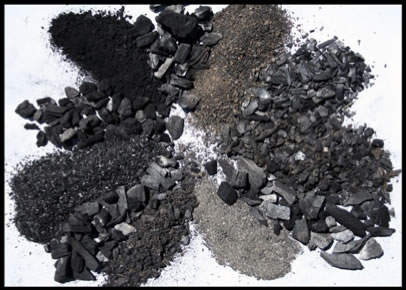 Biochar is a fine-grained charcoal like substance, with a very high carbon content pure carbon. In practice, biochar is the name given to charcoal when it is used for a particular purpose, e.g. a soil amendment rather than when it is to be burned as fuel. Like all charcoal, biochar is created by pyrolysis of biomass. Biochar is a stable solid full of pores that can be used to soak up water, nutrients and metals and thus is useful in a wide variety of applications.
Biochar is a fine-grained charcoal like substance, with a very high carbon content pure carbon. In practice, biochar is the name given to charcoal when it is used for a particular purpose, e.g. a soil amendment rather than when it is to be burned as fuel. Like all charcoal, biochar is created by pyrolysis of biomass. Biochar is a stable solid full of pores that can be used to soak up water, nutrients and metals and thus is useful in a wide variety of applications.
When used as an agricultural soil amendment, it improves soil fertility, the soil's ability to hold water and nutrients, and agricultural productivity in general. Pre-Columbian Amazonians are believed to have used biochar to enhance soil productivity. European settlers called it terra preta de Indio. When used in as a soil amendment. biochar can endure in soil for thousands of years, thus giving it the ability to sequester carbon recently in the atmosphere.
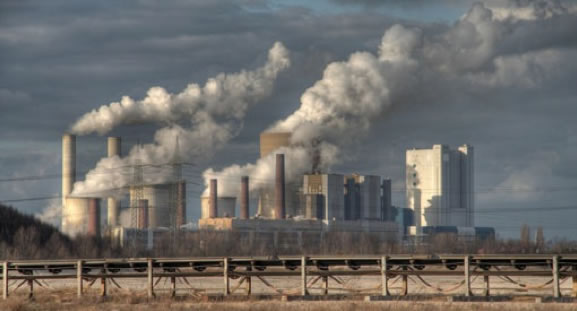 Use of biochar has also be identified as a key ingredient necessary to meet the mercury air pollution standards recently invoked by the EPA for coal-fired power plants, as well as for water filtration and cleaning up mine tailings, as can be seen below in photos from the Hope Mine near Aspen Colorado.
Use of biochar has also be identified as a key ingredient necessary to meet the mercury air pollution standards recently invoked by the EPA for coal-fired power plants, as well as for water filtration and cleaning up mine tailings, as can be seen below in photos from the Hope Mine near Aspen Colorado.

Currently the Phoenix Energy plants in Merced and Modesto are able to sell their biochar to local agriculture, largely in response to the drought and the fact that addition of biochar to the soil helps with water retention and thus allows use of significantly less water.
However, to assure that our project is financially viable we need to find a market for biochar that is more dependable and deal with businesses that are willing to commit to long term contracts. In this respect, the water and air filtration business seems like a more dependable market for our biochar. Right now most all water districts get their activated carbon from China and it is typically made by charing coconut shells/husks. Another very common source of activated carbon is coal. We would hope to be able to supply local County and nearby water and wastewater treatment plants with biochar from our operation.
Is biochar the same as activated carbon used for water filtration and pollution control?
Yes and no. As biochar comes out of the biomass pyrolysis unit, it is quite porous and "active" and capable of absorbing a significant quantity of organic molecules. For some applications however, larger pore sizes and a more open structure is required and for these applications, the biochar can be further activated, e.g. by treating it with high temperature steam.
We are currently collaborating with the Mariposa Public Utilities District and a professor at U.C. Merced on characterizing the biochar from the Phoenix Energy plants for its use in the water and air filtration, and how that biochar might be best activated for those uses.
Can biochar be used to sequester carbon and reverse global warming?

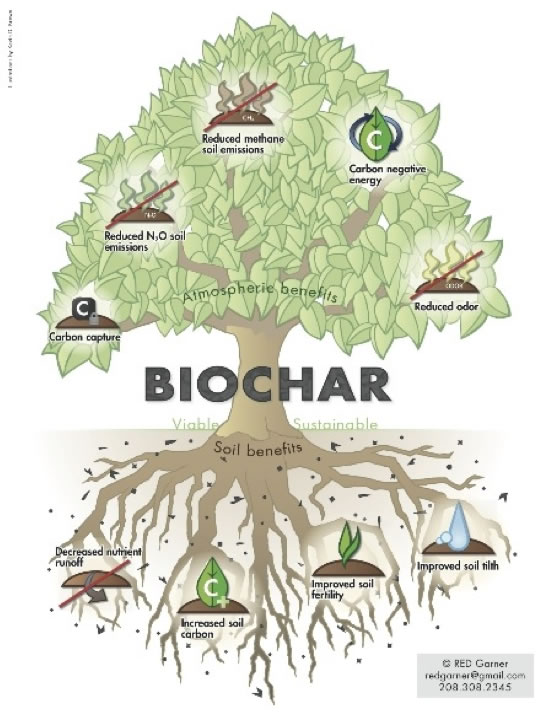
The graph above shows the atmospheric CO2 levels over the last 800 thousand years.
Before the start of the industrial revolution, the CO2 levels varied via natural causes between 180 and 280 ppm. However once we started burning fossil fuels for energy production, the CO2 levels starting rising to well above the historical natural variations exactly as predicted by Swedish scientists in the 1890s. The current CO2 level is now above 400 ppm and we are on a path to 450 ppm before we have any chance of reversing that trend, with dire consequences for the earth and its climate.
Can use of biochar as a soil supplement sequester carbon and help reduce atmospheric carbon levels to safer levels? It seems that the answer is yes!
When used as a soil amendment, biochar places carbon in the ground that was recently removed from the atmosphere by photosynthesis and keeps that carbon sequestered for 100s if not thousands of years. The 2014 IPCC Report (UN) on climate change not only emphasized the need to use renewable energy, it also identified biochar-based carbon sequestration as perhaps the only viable way of removing carbon from the atmosphere and reversing global warming.
It is early days, but a biomass reactor based on pyrolysis and biochar production has significant advantages in terms of the environment and climate change over the older style biomass reactors that simply burn biomass to generate electricity, but in the process quickly release significant amounts of greenhouse gasses into the atmosphere.
Is use of biochar for carbon sequestration geoengineering?
If done on an industrial scale, then the answer is certainly, yes it is geoengineering, in that the idea would be to sequester massive amounts of carbon and reverse global warming. The 2014 IPCC Report (UN), and articles that sumarize that report, mentioned that large-scale use of biochar for agriculture could be the only practical way of reversing global warming while increasing food production in areas with poor soils.
Other ideas that were mentioned in that report were fertilizing the ocean to promote algae growth and massive reforestation, but neither of these ideas are considered practical. The other geoengineering idea that is often mentioned is seeding the atmosphere was aerosols to block some of the sunlight reaching the earth surface. In comparison to these other ideas, use of biochar sounds pretty good. More scientific study of the idea is necessary before any large-scale production is undertaken, but in the meantime, small scale biomass facilities such as we are considering here will help facilitate fire safety and forest health while minimizing carbon dioxide and particulate emissions.
I don't believe in global warming, so why should I care about your project and sequestering carbon?
Anthropomorphic (caused by man's activities) global warming or climate change is not a matter of opinion or belief, but rather a widely agreed upon scientific consensus. Regardless, of whether any individual accepts the scientific consensus, the need to reduce carbon emissions and increase carbon sequestration is the law in California and more recently the nation. Projects in California that ignore the scientific and legal reality of climate change will not be approved and/or will be stopped via lawsuits from various environmental groups.
Regardless of one's political views on this subject, we all recognize the need to thin our forests for the sake of fire safety, water production and improved recreation. It is far better for all sides to get behind a project that is not only consistent with the law, but will also benefit economically from the various incentives available, or becoming available, for renewable energy and carbon sequestration. In terms of energy, water and land use, pyrolysis of forest biomass is more efficient than making ethanol from corn as a fuel.
A system similar to the one proposed here is being planned for North Fork and originally an environmental group opposed that facility, but withdrew their objections, largely because of the carbon sequestration associated with the biochar.

